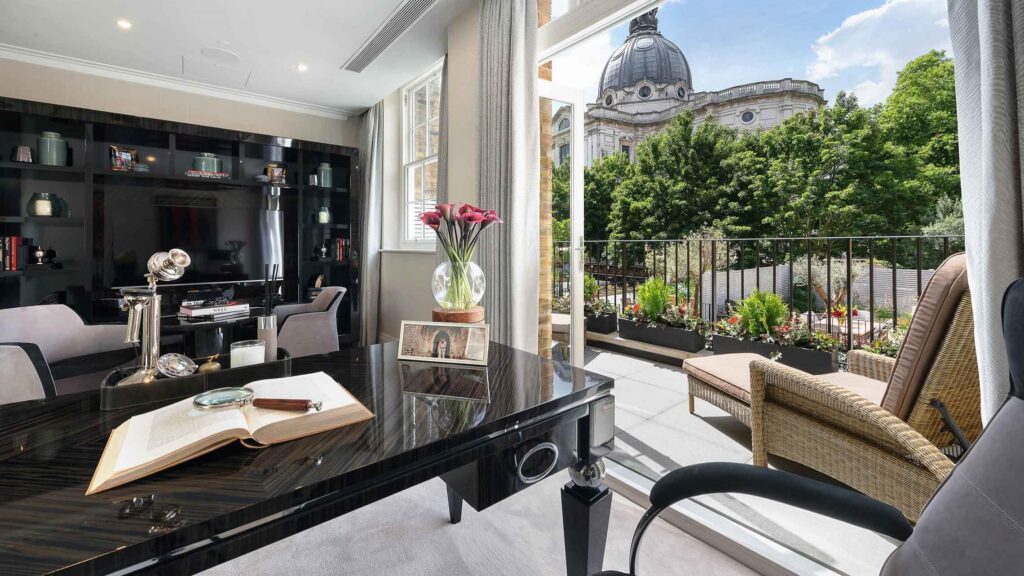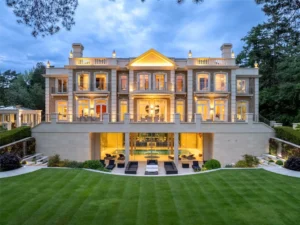A hush fell over the room on a crisp autumn evening in a dimly lit auction house in London’s Mayfair. The auctioneer’s gavel was poised to strike, and the tension was palpable as a collection of London’s finest luxury properties went under the hammer. Among the bidders were seasoned investors, international buyers, and a few curious onlookers. As the bidding war intensified over a stunning penthouse overlooking Hyde Park, it was clear that London’s luxury real estate market was as compelling and competitive as ever. With its expansive floor-to-ceiling windows, custom interiors, and breathtaking city views, the property finally sold for a jaw-dropping £25 million. For those in the know, this was just another day in London’s high-stakes real estate scene, where prime properties change hands at eye-watering prices. This article delves into the fascinating world of luxury real estate London, uncovering the trends, statistics, and key factors driving this prestigious market.
The Appeal of London’s Luxury Real Estate
London has long been a global hub for luxury real estate, attracting wealthy individuals and investors worldwide. The city’s unique combination of rich history, cultural vibrancy, political stability, and economic strength makes it an irresistible location for those seeking to invest in high-end properties.
According to a report by Knight Frank (2023), London remains one of the top three destinations for ultra-high-net-worth individuals (UHNWIs) looking to purchase luxury real estate. The report indicates that over 63% of UHNWIs consider London their preferred choice for property investment, second only to New York. The city’s appeal is further underscored by its status as a financial powerhouse, a cultural epicenter, and a city renowned for its educational institutions, such as the prestigious University College London (UCL) and the London School of Economics (LSE).
The Numbers Behind London’s Luxury Market
London’s luxury real estate market is characterized by properties that typically start at £2 million and can easily soar into the tens of millions, depending on location and features. According to Savills (2023), the prime central London (PCL) market saw a 3.4% increase in property values in the past year despite economic uncertainties brought on by global events like Brexit and the COVID-19 pandemic. This resilience is a testament to the enduring appeal of London’s luxury properties.
The most coveted areas in London for luxury real estate include Mayfair, Knightsbridge, Kensington, Chelsea, and Belgravia. These areas are home to some of the world’s most expensive properties, with average prices ranging from £4,000 to £10,000 per square foot (Knight Frank, 2023). For example, a recent sale in Knightsbridge saw a private mansion selling for over £200 million, setting a new benchmark for luxury property transactions in London (Bloomberg, 2024).
Factors Driving Demand in London’s Luxury Real Estate Market
Several factors continue to drive the demand for luxury real estate in London:
- International Buyers and Safe Haven Status
- London’s reputation as a “haven” for international investors remains a significant factor in its luxury real estate market. Political stability, a robust legal system, and transparent property laws attract foreign buyers, especially from the Middle East, Asia, and Russia. A report by JLL (2023) found that international buyers accounted for 45% of all luxury real estate transactions in London last year. The ongoing geopolitical tensions and economic uncertainties in various parts of the world have only heightened London’s allure as a secure investment destination.
- Limited Supply and High Demand
- The limited supply of luxury properties in prime central London contributes to sustained high prices. Strict planning regulations and the scarcity of land mean that new developments are few and far between. According to London Residential Research (2023), the number of newly built luxury properties in prime areas has decreased by 15% over the past five years, further driving demand for existing high-end homes.
- Currency Advantage for Foreign Investors
- Currency fluctuations have also played a role in boosting London’s luxury property market. The weakening of the British pound following Brexit made London properties more affordable for foreign investors. As per Currency Solutions (2023), investors using the US dollar or Euro have found up to 30% more purchasing power in London’s luxury market since 2016.
- Lifestyle and Amenities
- Beyond financial incentives, London offers a lifestyle that few cities can match. London’s luxury offerings are unmatched, from world-class shopping in Harrods and Selfridges to fine dining at Michelin-starred resLondon’s like The Ledbury and The Ritz. Furthermore, proximity to iconic landmarks such as Buckingham Palace, the Houses of Parliament, and Hyde Park adds a unique allure. High-net-worth individuals often seek properties that offer a home and a statement of wealth and taste.
Emerging Trends in the Luxury Market
Several key trends have emerged in LLondon’sluxury real estate market over the past few years:
- Sustainability and Green Living: There is a growing demand for luxury properties incorporating sustainable building practices and eco-friendly amenities. Features like energy-efficient heating, solar panels, and sustainable materials are becoming increasingly desirable. According to the Knight Global Buyer Survey (2023), 32% of buyers now consider sustainability a key factor when purchasing a luxury property.
- Technology Integration: Modern luxury homes in London are increasingly equipped with state-of-the-art technology, from smart home systems to private cinemas and high-tech security features. A survey by Luxury Property Showcase (2023) revealed that 45% of buyers are willing to pay a premium for homes with advanced technology and integrated smart systems.
- Post-Pandemic Preferences: The COVID-19 pandemic has reshaped buyer preferences, emphasizing larger living spaces, home offices, and outdoor areas. Savills reports a 20% increase in demand for properties with substantial gardens or terraces and additional rooms that can serve as home offices or gyms (Savills, 2023).
The Future of LLondon’sLuxury Real Estate Market
Despite global economic uncertainties, the outlook for LLondon’sluxury real estate market remains robust. A combination of limited supply, strong demand from international buyers, and London’s enduring appeal as a global city suggests that prices will continue to climb more moderately than in previous years.
Knight FFrank’s forecast (2024) projects a 2-3% annual growth in prime central London property values over the next five years, driven by sustained international demand and the city’s continued appeal as a luxury destination. Meanwhile, the upcoming infrastructure projects, such as the Crossrail 2, are expected to enhance connectivity, potentially increasing property values further in central London areas.
Conclusion
London’s luxurious real estate market remains a dynamic and enticing investment landscape for the wealthy. The city’s unique blend of historical charm, cultural richness, political stability, and economic opportunity continues to attract global clientele, ensuring its luxury properties remain in high demand. While the market has challenges, such as political uncertainties and economic fluctuations, LLondon’sstatus as a premier destination for luxury real estate appears secure. For investors and buyers alike, understanding the nuances of this market and staying attuned to emerging trends will be key to navigating and thriving in this high-stakes arena.






